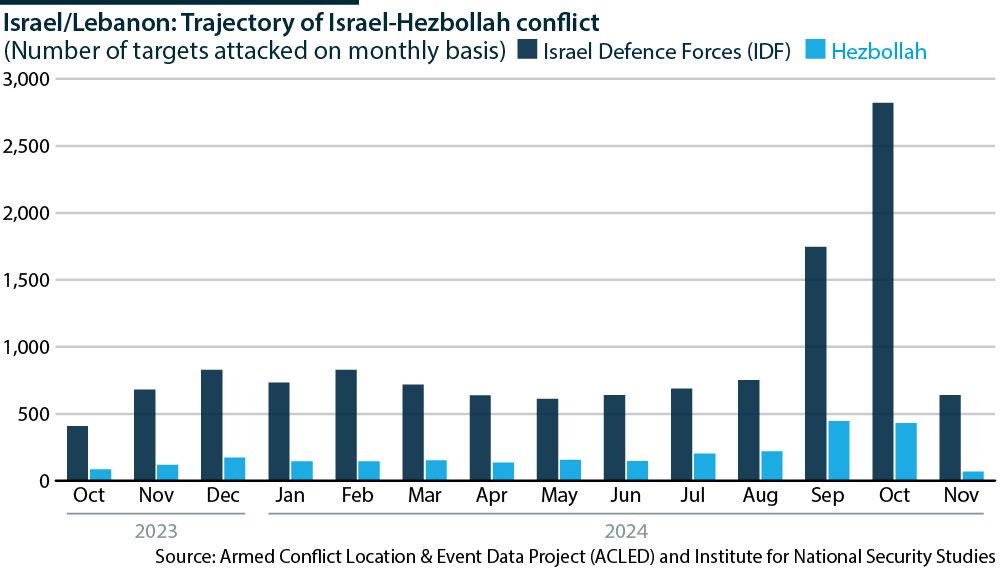Domestic considerations drive the Shia political-military movement’s caution about assisting longstanding backer Tehran
On June 13, political-military Shia movement Hezbollah said it would not retaliate against Israel’s airstrikes on Iran. Hezbollah’s decision reflects a strategy of self-preservation, following its devastating war with Israel in 2024. It also aligns with Iran’s decision so far not to activate its proxy networks or expand attacks to other regional countries, which would risk triggering a wider conflagration and undercutting support for Tehran among Arab and Muslim states.
What’s next
The costs of becoming entangled in the Iran-Israel war are too high for Hezbollah. Doing so would invite more destructive Israeli attacks that would degrade the group’s remaining capabilities, while domestic calls for its definitive disarmament would grow even more strident. Hezbollah’s Shia constituency, still suffering the devastation of the 2024 war, also has no appetite for further suffering. Even so, if Iran faced collapse or the United States joined the war, Hezbollah’s priorities might shift.
Subsidiary Impacts
- Hezbollah’s participation in the Israel-Iran war would force the Lebanese Armed Forces (LAF) to intervene, which could lead to civil war.
- The international community may more explicitly link aid and reconstruction finance to Hezbollah’s disarmament.
- Palestinian groups could attack Israel in reaction against LAF plans to disarm Palestinian camps.
- A devastating attack on Iran’s Fordow nuclear facility might force Tehran to call on regional allies to attack Israel.
Analysis
On June 14, the Lebanese press reported that the government had reached an informal security agreement with Hezbollah to stay out of the Israel-Iran war (see ISRAEL/IRAN: New war will reshape the Middle East – June 13, 2025). The agreement was reportedly the result of intensive diplomatic efforts, backed by France and the United States.
The LAF apparently threatened Hezbollah and Palestinian groups Hamas and Islamic Jihad with a military confrontation if they were to stage attacks on Israel from Lebanese soil or target US interests in the country. There are also indications that immediately prior to its ‘Operation Rising Lion’ against Iran, Israel warned of a full-scale attack on Hezbollah in Beirut and that it would occupy the Eastern Bekaa Valley, unless the LAF prevented Hezbollah from attacking its territory.
Credible threats of LAF and Israeli attacks restrained Hezbollah
Diplomatic intervention from the United States and France, as well as Hezbollah’s compliance with LAF demands, guaranteed Lebanon’s non-engagement in the war. This picture of diplomatic coordination squares with positive reports from a June 11 meeting between head of Hezbollah’s parliamentary bloc Mohammed Raad and French special envoy Jean-Yves Le Drian.
Hezbollah holds back
The 2024 Israel-Hezbollah confrontation showed how deeply Israel had infiltrated the group. Israeli forces successfully eliminated its leadership and decimated its military capacity (see ISRAEL/LEBANON: A fragile truce will set in – December 6, 2024).
Despite a ceasefire in place since November 2024, Israeli drones continue to target Hezbollah. As recently as June 5, Israel attacked an alleged drone production facility in the southern suburbs of Beirut, even after the LAF had inspected the site (see LEBANON: Hezbollah may struggle with a new phase – March 24, 2025).
The cost of involvement in the Iran-Israel war is too high for Hezbollah
Nonetheless, the ceasefire has probably given Hezbollah respite to regroup and rearm, albeit in a limited area north of the Litani river. South of the river, Israel claims to have destroyed 90% of Hezbollah’s infrastructure. Prime Minister Nawaf Salam said on June 4 that the LAF has dismantled more than 500 military positions and arms depots in the area.
An attack on Israel now would be met with demands rather than requests from the LAF to inspect sites north of the Litani, extending into the southern suburbs of Beirut. That could be the first step towards full disarmament, something Hezbollah wants to avoid. In response to Israeli complaints, the international monitoring committee charged with implementing the ceasefire has in recent months pushed such requests (see LEBANON: Hezbollah faces unrelenting push to disarm – April 9, 2025).
Although the Israel Defence Forces (IDF) diminished Hezbollah’s rockets stockpile in the war, the group may still have the capability to land a series of blows to northern Israel. However, the price for that is likely too heavy for its new leadership. The group’s long-term goal of remaining an armed force within Lebanon would be compromised if it invited massive aerial attacks now.
A diminished entity
Hezbollah’s defeat in the war with Israel and the killing of its charismatic leader Hassan Nasrallah have transformed it. The IDF estimates that it more than halved Hezbollah’s military capacity:
- Around 70% of its firepower at various ranges was destroyed, as was much of the tunnel network in south Lebanon.
- About 4,500 military personnel were killed and a further 9,000 wounded (nearly half of its regular fighting force).
- Its progress in rebuilding militarily will be slow, as it is no longer able to import Iranian weapons via Syria or Beirut airport, due to stringent border security measures.
With the loss of deterrence, Hezbollah now faces strong and rising calls inside Lebanon to disarm and become a regular political party.

Hezbollah has also suffered damage to its financial system, including al-Qard al-Hasan Association — the Hezbollah-linked financial institution that provides aid to its Shia constituency (see LEBANON: Risk of civil and sectarian unrest will rise – October 22, 2024). This has made it difficult to support the recovery from the war.
The UN estimates that 92,000 civilians are still unable to return to their homes after the conflict. For them and many others, economic recovery and reconstruction will take precedence over ideology.
With limited popular appetite for war in the Shia community, and hardly any outside it, war now would mean a major political setback for Hezbollah. In his initial response on June 13, Secretary-General Naim Qassem condemned the attacks on Iran but stopped short of promising military support.
He and the party’s leadership view the current period as one when Lebanese concerns supersede regional ones. From a historical perspective, the movement has been through other such periods, while remaining ideologically committed to the long-term goal of resistance.
Scenarios for war
It would probably take an existential threat to Iran and its theocratic Shia system, with which Hezbollah is deeply ideologically aligned, for the group to enter the conflict.
If, for instance, the United States were to take part and successfully destroy Iran’s Fordow nuclear facility, the loss of that last deterrent could trigger a desperate call from Tehran for Hezbollah to attack Israel with its remaining rockets. Hezbollah may still possess several types of long-range rockets that it did not use in the 2024 fighting.
US involvement could also trigger irregular warfare against US — and possibly French and UK — interests, in the region and beyond. Hezbollah is unlikely to join such attacks unless the war appears to threaten the Iranian government’s survival. Even in that case, the group might decide to shore up its Lebanese position rather than sacrificing itself for a moribund regime.
Meanwhile, internal criticism of Qassem’s policy towards Tehran could create divisions within Hezbollah. So far, calls for a return to a more hardline confrontational approach, although they exist in the movement, have been kept contained and do not appear to have wide currency, given the clear dangers. However, this could change as tensions mount.
Iran’s Foreign Minister Abbas Araghchi lays a wreath of flowers at the grave of former Hezbollah leader Hassan Nasrallah, June 3, 2025 (Anwar Amro/AFP/Getty Images)
Analyst

Dr. Laura James
Deputy Director & Senior Analyst, Middle East

